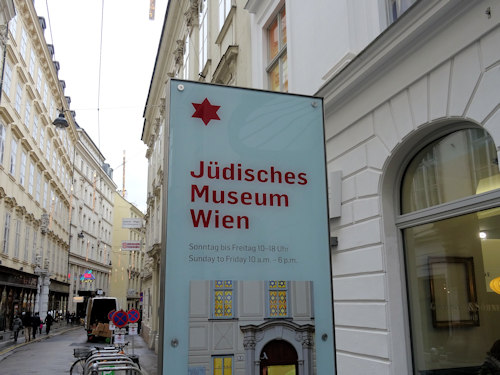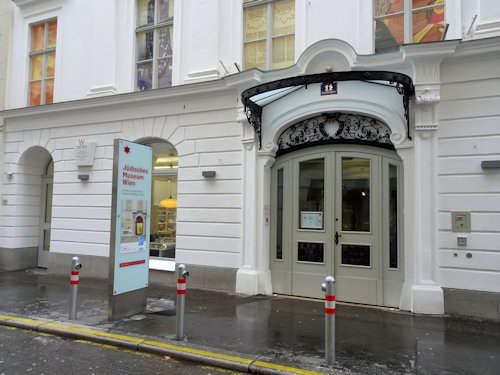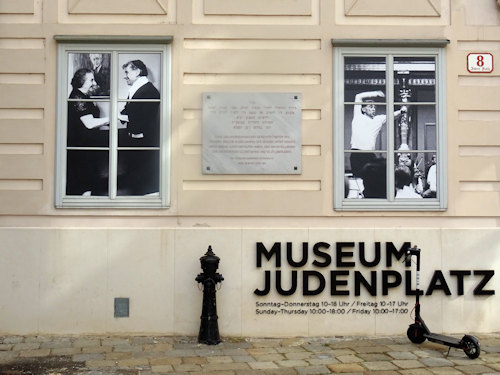Tucked away inside Vienna’s old town is the Jewish Museum; a centre of art, culture and history that pays testament to the key role played by the Jewish community in the city’s past and present.
Equally, the museum offers thought-provoking insights into the Jewish experience and the struggle against antisemitism.
- Explore the history of the Jewish community in Vienna
- Single ticket covers two locations
- Permanent exhibitions open your eyes
- Notable current/future exhibitions:
- Peace (until May 26th, 2024)
- Who Cares? (until Sept 1, 2024)
- Viennese Nostalgia (until Sept 1, 2024)
- Book Jewish Museum tickets* online
- See also:
- Holocaust & Wall of Names memorials
- Peace exhibition (until May 26, 2024)
An intimate journey

(In the heart of the old town)
The Jewish museum in Vienna offers a poignant overview of the history of the Jewish people in Austria and, most importantly, the relationship between community and country.
In doing so, the museum creates a paradox for a non-Jew like me.
The displays are at once shocking and not shocking enough. Celebratory and reaffirming, but also terrifying and depressing. (I’ll explain what I mean in my review below of the permanent exhibitions.)
The main museum site on Dorotheergasse houses the permanent collections and Our City! exhibition, with space for regular special exhibitions (one small one in a single room and a major exhibition that fills several galleries.)

(View of part of the main exhibition at Judenplatz; press photo © Ouriel Morgensztern)
A second site on Judenplatz hosts a small special exhibition and the permanent Our Medieval City! exhibition, which includes the remains of a medieval synagogue.
Those special exhibitions at the two sites never cease to intrigue, inspire, and/or inform. Topics covered might relate to history, a family or individual biography, art, culture, religion or a cross-genre mix.
Both museum buildings have an extensive history that predates their current use.
The Dorotheergasse address is actually Palais Eskeles, an aristocratic townhouse that traces its roots back to the early 15th century and beyond.
The Judenplatz address is the Misrachihaus, which has its origins in the middle ages, when Vienna was merely the centre of a newly-founded duchy.
The permanent displays
The museum hosts various permanent installations and displays, but the central ones are:
Our city!

(The Jewish Museum location on Dorotheergasse)
The ground and second floors of the main museum deal with the history of the Jewish community in Vienna.
One half tackles the rebuilding of this community after WWII. The other addresses the time before WWII, particularly the role played by Jews in Viennese life and the three periods of often violent and deadly expulsion (in 1421, 1670, and under the Nazis).
The presentations seem to walk a pragmatic line between expressing justified outrage and recognising the delicacy required when dealing with certain themes.
The photos, documents and day-to-day items sometimes make for difficult viewing. But not in the sense you might imagine. The “horror” of oppression, racism, and, at times, genocide is never graphical but implied.
This horror lives in the throwaway remarks of post-WWII politicians, the insidiousness of antisemitic media images, and the initial reluctance to officially accept Austrian complicity in the Holocaust.
It radiates from the careful graphics of Nazi administrators as they describe Jewish emigration or the casual use of Jewish caricatures in 19th-century walking sticks.
It emerges in society’s willingness to value music and science, but reject the Jewish musicians and scientists who produced it. Freud, for example, fled Vienna in 1938.
And then, among the negativity, you find the expression of Jewish community and achievement, the optimism of family and community life…indeed, the normality of family and community life, even in challenging circumstances.
When I left, I wondered if the exhibition was too gentle, too easy on the guilty: I saw no images of concentration camp victims, for example. But that would, I imagine, be too personal for many visitors, and the message comes across, indirectly, anyway.
Besides, in the end, the dominant theme is resilience.
It all makes for a thought-provoking experience.
Our Medieval City!

(The Jewish Museum location on Judenplatz)
As well as housing a special exhibition, the Judenplatz site takes you underground to the remains of the synagogue burnt down in the 1421 destruction of the Jewish community in Vienna.
The permanent exhibition introduces you to medieval Jewish life, but also covers the story of the project to erect the Holocaust memorial on Judenplatz square outside (the remnants of the synagogue actually extend out below the memorial).
Tickets & visitor tips
Tickets bought at one site are valid for the other site, too, for four days after purchase.
(Booking service provided by Tiqets.com*, who I am an affiliate of)
- The main site has a supervised cloakroom with lockers available at both sites
- All labels and overview texts are in both German and English (same goes for the special exhibitions)
- The Dorotheergasse site includes a nice shop and a small café. The former sells a better-class of souvenir, as well as books, exhibition catalogues, crockery and clothing
How to get to the Jewish Museum
Dorotheergasse site
The museum lies a short walk away from the very central Stephansplatz subway station, served by the U3 and U1 lines.
Alternatively, take bus 2A to Plankengasse or either the 2A or 1A to Habsburgergasse.
The site sits right in among Vienna’s beautiful old town, not far from the cathedral, Hofburg palace, Spanish Riding School, Café Hawelka (do try the Buchteln sweet pastries), and other city centre sights.
A bit of bonus trivia for you: Dorotheergasse and the entrance to the museum actually made a brief TV appearance in Episode 3 of the third season of Amazon’s Tom Clancy’s Jack Ryan CIA drama production.
Address: Dorotheergasse 11, 1010 Vienna | Website
Judenplatz site
The 1A and 3A bus have a stop nearby (Schwertgasse). It’s also just a short walk away from three subway stations:
- Schottentor: U2 (and also the 1, 37, 38, 40, 41, 42, 43, 44, D and 71 trams)
- Herrengasse: U3
- Stephansplatz: U1 and U3
Be sure to drift through the square outside. The surrounding buildings date back to the time of Mozart (who actually lived on the square, albeit in a house that has since been torn down. Music really is everywhere in this city).
Address: Judenplatz 8, 1010 Vienna | Website
